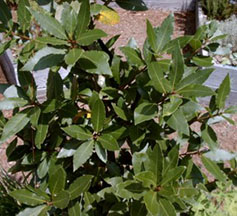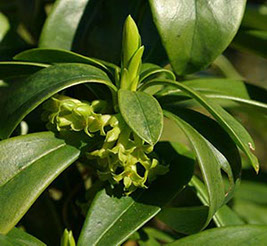Make the most of culinary herbs and spices.
Nine Ways to Enjoy the Herb of the Year 2009: Bay Leaves
by Sandra Bowens

Each year since 1995 the International Herb Association and the Herb Society of America have announced their choice for the Herb of the Year. They have selected bay laurel for 2009. To qualify as an herb of the year, a plant must meet two of three criteria. It must have culinary applications, medicinal properties and/or be useful to crafters. Like calendula, last year's Herb of the Year, bay leaves meet all three of these requirements.
Although you are probably familiar with the leathery leaf, perhaps it is time to get to know the Herb of the Year even better. In that spirit, allow us to offer the following nine points.
1. Know the difference. Just because a plant has laurel in its name doesn't mean that we want to cook with it. Our herb of the year is Laurus nobilis, bay laurel. These are the leaves of a tree that may grow to be 15 feet or more. It is easy confuse the bay laurel with other plants that are inedible and sometimes even toxic. Don't use the leaves from these plants in the kitchen:



Kalmia latifolia, or Mountain Laurel. Native to Europe, now found in the eastern United States. All parts of this plant are highly poisonous. Image courtesy of wikimedia.commons
Umbellularia californica, also known as California Bay Laurel and Oregon Myrtle. Native to the Pacific Northwest United States. It's edibility is debatable, can cause stomach distress. Image courtesy of wikimedia.commons
Daphne laureola. Bay laurel trees are sometimes called daphne but this shrub is another poisonous plant. Image courtesy of wikimedia.commons
2. Make a stew. The most common use of bay leaves is to season long-simmering soups and stews. Bay leaves are subtle and combine well with other herbs. Recipes from this site you might want to try: My Best Chili, Basic Chicken Stock
or Smoky Chicken and Vegetable Soup. Remove the leaf before serving so no one eats it, they have been known to be a choking hazard.
3. Thread a kabab. Add flavor and aroma to shish-kabob in one of two ways. Add a leaf between the cubes of meat or veggies on a skewer before grilling or use a stem from the bay tree as the skewer.
4. Plant a pot. Bay laurel makes a lovely addition to the herb garden. It is well-suited to growing in a pot, as well, especially if your winter temperatures drop below around 20 degrees (F). Then you can take it indoors during those harsh conditions.
5. Take a bath. Bay leaves have astringent properties which make for an invigorating addition to your bath. Simply steep a handful in boiling water for a few minutes and then add the strained water to your bath water. Even easier, make it a facial by dropping a quarter cup of leaves into a quart of boiling water. Hold a towel over your head and let the steam dance over your face.
6. Chase away a pest. Old wives will tell you that a few bay leaves dropped into the flour canister will keep away those creepy crawlers. Ditto for dried beans and rice. You will never know if it works if you don't give it a try.
7. Make a wreath. Early Olympians wore crowns of bay leaves to signify glory. Scholars did the same, hence the word "baccalaureate." You don't have to wear your bay leaves but a wreath or swag does make a nice decoration for your home. Find the directions for making one here.
8. Soothe your tummy. While not a proven remedy, old herbals suggest taking a tea of bay leaves to alleviate an upset stomach or a bout of flatulence. A couple of leaves in boiling water would be pleasant no matter how you're feeling.
9. Pair with flowers. Branches of bay leaves, so shiny and erect, will enhance a flower arrangement as background filler or add interest along with other evergreen sprays in those dark days of winter when flowers are in short supply.
10. Find out even more. This site has pages dedicated to the noble bay. Read the article "All About Bay Leaves." See what others have been wondering about at the "Bay Leaf Questions and Answers Page."
Whoops! We were only supposed to have nine points on this list!
Here's one that's full of our favorite recipes because we wrote the book! It is also full of information, helpful hints and ideas for using herbs and spices in your kitchen.
Other articles you might enjoy:
1. All About Calendula: Herb of the Year 2008
2. All About Lemon Balm: Herb of the Year 2007
3. Herb of the Year 2006: A Salute to Scented Geraniums
4. Herb of the Year 2005: Oregano, Family and Friends
5. Herb of the Year 2004: Good Old Garlic
Go home with the Herbfarm's award-winning chef as he shows you how to prepare these simple yet utterly delightful recipes.




